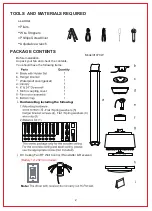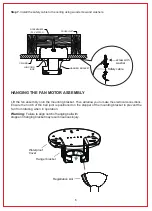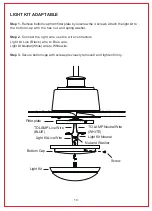
13
TROUBLESHOOTING
Problem
Solutions
Fan will not start.
Fan sounds noisy.
Fan wobbles
CARE OF YOUR FAN
Here are some suggestions to help you maintain your fan.
1. Because of the fan's natural movement, some connections may become loose. Check the support
connections, brackets, and blade attachments twice a year. Make sure they are secure. (It is not
necessary to remove fan from ceiling.)
2. Clean your fan periodically to help maintain its new appearance over the years. Use only a soft brush or
lint-free cloth to avoid scratching the finish. The plating is sealed with a lacquer to minimize discoloration
or tarnishing. Do not use water when cleaning. This could damage the motor, or the wood, or possibly
cause an electrical shock.
3. You can apply a light coat of furniture polish to the wood blades for additional protection and enhanced
beauty. Cover small scratches with a light application of shoe polish.
4. There is no need to oil your fan. The motor has permanently lubricated bearings.
WARNING:
Failure to disconnect power supply prior to troubleshooting any wiring issues may result in serious injury.
- Check circuit fuses or breakers.
- Check line wire connections to the fan and switch wire connections in the switch housing.
- Make sure all motor housing screws are snug.
- Make sure the screws that attach the fan blade bracket to the motor hub is tight.
- Make sure wire nut connections are not rubbing against each other or the interior
wall of the switch housing.
- Allow a 24-hour "breaking-in" period. Most noise associated with a new fan
disappear during this time.
- If using an optional light kit, make sure the screws securing the glassware are tight.
Check that light bulb is also secure.
- Some fan motors are sensitive to signals from solid-state variable speed controls.
If you have installed this type of control, choose and install another type of control.
- Make sure the upper canopy is a short distance from the ceiling. It should not
touch the ceiling.
- Check that all blade and blade arm screws are secure.
- Most fan wobbling problems are caused when blade levels are unequal. Check this
level by selecting a point on the ceiling above the tip of one of the blades. Measure
this distance. Rotate the fan until the next blade is positioned for measurement.
Repeat for each blade. The distance deviation should be equal within 1/8".
- Use the enclosed Blade Balancing Kit if the blade wobble is still noticeable.
- If the blade wobble is still noticeable, interchanging two adjacent (side by side)
blades can redistribute the weight and possibly result in smoother operation.
Содержание 1070W
Страница 16: ...RP 100919...


































